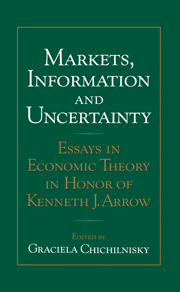Book contents
- Frontmatter
- Contents
- Preface
- List of contributors
- Section I Information and markets
- Section II Uncertainty and finance
- 3 The formulation of uncertainty: Prices and states
- 4 A remark on incomplete market equilibrium
- 5 Existence and optimality of a general equilibrium with endogenous uncertainty
- 6 Market equilibrium with endogenous price uncertainty and options
- 7 Catastrophe futures: Financial markets for unknown risks
- Section III Market externalities and justice
- Author index
- Subject index
3 - The formulation of uncertainty: Prices and states
Published online by Cambridge University Press: 05 December 2011
- Frontmatter
- Contents
- Preface
- List of contributors
- Section I Information and markets
- Section II Uncertainty and finance
- 3 The formulation of uncertainty: Prices and states
- 4 A remark on incomplete market equilibrium
- 5 Existence and optimality of a general equilibrium with endogenous uncertainty
- 6 Market equilibrium with endogenous price uncertainty and options
- 7 Catastrophe futures: Financial markets for unknown risks
- Section III Market externalities and justice
- Author index
- Subject index
Summary
The states revolution of 1952
The seven-page paper by Kenneth Arrow (1953) “Rôles des valeurs boursiéres pour la répartition la meilleure des risques” has changed the formulation of uncertainty in economic theory, and has led to significant advances in our understanding of resource allocation under uncertainty. Earlier discussions, including, for instance, those of Hicks (1931), Marschak (1938), or Tintner (1941), introduced as primitives probability distributions for some characteristics of the environment (technology, resource, tastes, etc.), and also for some economic variables (prices, incomes, production rates, etc.). The revolution initiated by Arrow consisted in exploiting fully the clarification permitted by the concept of “states of the environment.”
In the theory of resource allocation under certainty, we start from a given environment: commodities, with associated initial resources; consumers, with associated consumption sets, preferences, and property rights; producers, with associated production sets. Arrow had a genial perception. (I guess he was inspired by his familiarity with statistical decision theory – providing a notable instance of transfer of concepts across disciplines.) Uncertainty means that the environment is not given; instead, there exists a set of alternative, mutually exclusive “states of the environment,” one and only one of which will materialize. The results obtained for a given environment apply to an uncertain environment, if a commodity is defined not only by its physical properties (including the time and place at which it is available), but also by an event (set of states) conditional on which it is available.
- Type
- Chapter
- Information
- Markets, Information and UncertaintyEssays in Economic Theory in Honor of Kenneth J. Arrow, pp. 45 - 66Publisher: Cambridge University PressPrint publication year: 1999
- 2
- Cited by



